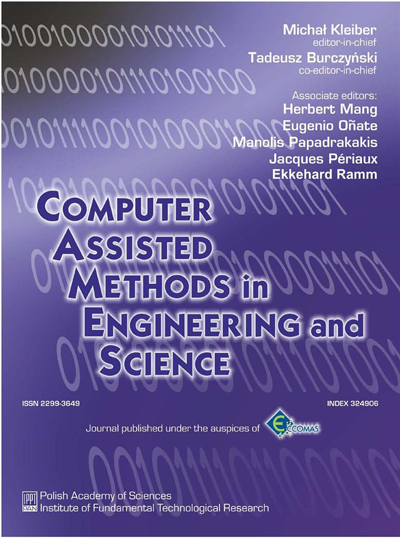Identification problems of Recurrent Cascade Neural Network application in predicting an additional mass location
Abstract
The paper is a development of research originated in [8]. The identification problem deals with searching the location of a small mass attached to a steel plate. The corresponding inverse problem is based on measurement of dynamic plate responses on a laboratory model of the plate, taking into account only the bending plate eigenfrequencies. In the inverse analysis the Recurrent Cascade Neural Network was applied, developed in [3]. Much attention is paid to recognition of identification possibilities of RCNN. The testing process is in fact an unsupervised learning, which can lead to unstable and inaccurate recurrence procedure. That is why the verification testing process was carried out adopting the barrier bound approach. These problems are discussed in the present paper.
Keywords
laboratory model of plate, plate eigenfrequencies, Recurrent Cascade Neural Network (RCNN), supervised and unsupervised learning, verification testing, barrier bound,References
[1] K. Dems, Z. Mroz. Identification of damage in beam and plate structures using parameter-dependent frequency changes. Eng. Comp., 18: 96–120, 2001.[2] S. Haykin. Neural Networks – A Comprehensive Foundation, 2nd ed. Prentice-Hall, Upper Saddle River, 1999.
[3] M. Kłos, Z. Waszczyszyn. Modal analysis and modified cascade neural networks in identification of geometrical parameters of circular arches. Computers & Structures, 89: 581–589, 2011.
[4] T. Masters. Practical Neural Network Recipes in C++. Academic Press, 1993.
[5] Neural Network Toolbox for Use with MATLAB, User’s Guide, Version 4. The MathWorks, Inc., Natick, MA, 2000.
[6] E. Pabisek. Hybrid Systems Integrating FEM and ANN for the Analysis of Selected Problems of Structural and Material Mechanics, D.Sc. Dissertation, Monograph 369, Series of Structural Engineering. Cracow University of Technology. Cracow, 2008.
[7] D.T. Pham, X. Liu. Neural Networks for Identification and Control, 2nd ed. Prentice–Hall, 2000.
[8] G. Piątkowski. Damage Detection in Structural Elements Applying Artificial Neural Networks (in Polish). Ph.D. Dissertation, Rzeszów University of Technology, 2003.
[9] G. Piątkowski, L. Ziemiański. The solution of an inverse problem in plates by means of artificial neural networks. In: L. Rutkowski et al. [Eds.]. Artificial Intelligence and Soft Computing – ICAISC 2004, LNAI 3070, 1087–1092. Springer, 2004.
[10] Z. Waszczyszyn, M. Słoński. Selected problems of artificial neural networks development. In: Z. Waszczyszyn [Ed.], Advances of Soft Computing in Engineering, CISM Courses and Lectures, vol. 512, Springer, Wien New York, 2010.
[11] Z. Waszczyszyn, L. Ziemiański. Neural networks in the identification analysis of structural mechanics problems. In: Z. Mróz, G. Stavroulakis [Eds.]. Parameter Identification of Materials and Structures. CISM Lecture Notes, vol. 469, 265–340. Springer, Wien New York, 2005.




